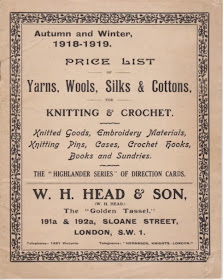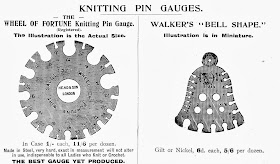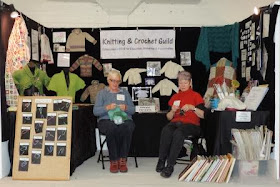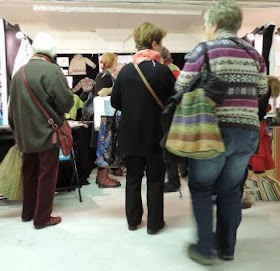 |
| The Universal Knitting Book, Paton's, 1913 |
It is printed on very cheap paper, with thin card covers - evidently not designed for durability. Paton's also published a much more substantial Knitting & Crochet Book at the same time, on glossy paper and with a cloth binding, priced at a shilling (12d), so The Universal Knitting Book was aimed at the cheaper end of the market. The cover features a small girl, who looks surprisingly grumpy, sitting on top of a globe (representing the universe, presumably) while knitting. The preface promises a "lavish supply of illustrations". Most are line drawings, and perfectly clear, but a few are taken from photographs (perhaps to be up-to-date) and have not reproduced well on the cheap paper.
The intention in publishing booklets like this was obviously to sell the company's yarn. The first page of The Universal Knitting Book is very persuasive about the advantages of knitting for yourself and your family, and using Paton's yarn:
"Have you ever thought how much more pleasure there is in wearing garments which you have knitted yourself? Not only is there a pleasure in wearing the garments, but they can be so easily made in odd moments which might otherwise be wasted, and if made with Paton's Alloa Knitting Wools, you are assured of splendid wearing qualities and perfect comfort and warmth, without excessive weight....
But the universal reputation which our Wools enjoy has not been secured, nor is it maintained, without great vigilance on our part. Nothing in the way of care or skill, or improved mechanical appliance, has been spared to bring all our qualities to a high state of excellence; and we believe we only express the opinion of the vast majority of those accustomed to handle knitting wools, when we say that, alike in respect of quality, finish, and durability, they are not surpassed by those of any other maker. They give the maximum of satisfaction to the knitter, and of comfort to the wearer."
That is a great slogan for a spinning company: "the maximum of satisfaction to the knitter, and of comfort to the wearer." Exactly what we all want from our yarn. (Plus it has to look good, of course.)
The booklet has patterns for a wide range of garments for men, women and children, beginning with two chapters on socks. The first is a highly technical chapter giving rules and general directions for Stocking Knitting. It discusses the different parts of a stocking and how to adjust the size to fit a specific foot and leg. It seems an oddly advanced beginning for a booklet aimed at all levels of experience. The next chapter has patterns for socks and stockings, with several fancy sock tops for Gentleman's Cycling Stockings.
 |
| A thistle pattern for a stocking top |
 |
| Lady's Under Bodice |
The next chapter has outer garments - coats, jerseys, sweaters and jackets - and begins with instructions for knitting a simple cable, perhaps a novel idea at the time. For the cable needle, "a broken hair-pin answers very well" - evidently broken hair-pins were plentiful in 1913. Some of the cardigans and waistcoats in this chapter look quite modern.
 |
| Jersey & Knickers for a boy of 2 to 3 years of age |
 |
| Baby's Boot |
Then there are Hoods, Clouds and Caps, including two patterns for helmets - they are not called Balaclava helmets, but that's what they are. And a chapter on scarves and comforters, including gloves and mittens.
 |
| Helmet |
 |
| Shetland Pattern Shawl |
The remaining chapters give a similar range of garments in crochet.
In 1920, Paton's merged with J. & J. Baldwin of Halifax, who were already publishing a similar booklet, Woolcraft. (I'll write about Woolcraft some time.) For a few years, the merged company continued to publish updated editions of both Woolcraft and The Universal Knitting Book. Eventually, only Woolcraft survived, though it incorporated some features of the other booklet. But although it wasn't as long-lived as Woolcraft, this 1913 edition of The Universal Knitting Book gives a fascinating view of what knitters were making, and wearing, on the eve of the Great War.







































 .
. 




